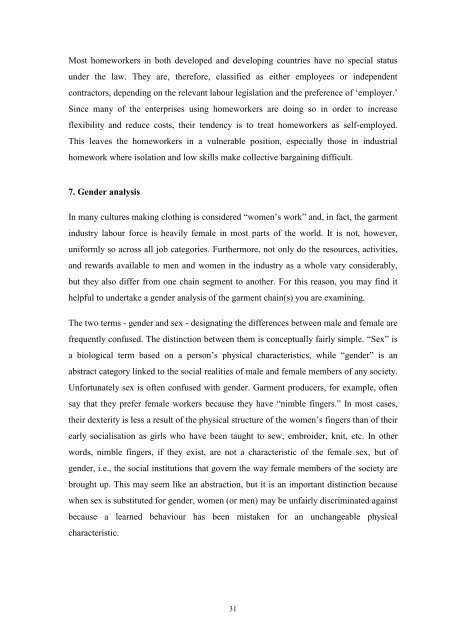McCormick+Schmitz Handbook for value chain research on - PACA
McCormick+Schmitz Handbook for value chain research on - PACA
McCormick+Schmitz Handbook for value chain research on - PACA
You also want an ePaper? Increase the reach of your titles
YUMPU automatically turns print PDFs into web optimized ePapers that Google loves.
Most homeworkers in both developed and developing countries have no special status<br />
under the law. They are, there<str<strong>on</strong>g>for</str<strong>on</strong>g>e, classified as either employees or independent<br />
c<strong>on</strong>tractors, depending <strong>on</strong> the relevant labour legislati<strong>on</strong> and the preference of ‘employer.’<br />
Since many of the enterprises using homeworkers are doing so in order to increase<br />
flexibility and reduce costs, their tendency is to treat homeworkers as self-employed.<br />
This leaves the homeworkers in a vulnerable positi<strong>on</strong>, especially those in industrial<br />
homework where isolati<strong>on</strong> and low skills make collective bargaining difficult.<br />
7. Gender analysis<br />
In many cultures making clothing is c<strong>on</strong>sidered “women’s work” and, in fact, the garment<br />
industry labour <str<strong>on</strong>g>for</str<strong>on</strong>g>ce is heavily female in most parts of the world. It is not, however,<br />
uni<str<strong>on</strong>g>for</str<strong>on</strong>g>mly so across all job categories. Furthermore, not <strong>on</strong>ly do the resources, activities,<br />
and rewards available to men and women in the industry as a whole vary c<strong>on</strong>siderably,<br />
but they also differ from <strong>on</strong>e <str<strong>on</strong>g>chain</str<strong>on</strong>g> segment to another. For this reas<strong>on</strong>, you may find it<br />
helpful to undertake a gender analysis of the garment <str<strong>on</strong>g>chain</str<strong>on</strong>g>(s) you are examining.<br />
The two terms - gender and sex - designating the differences between male and female are<br />
frequently c<strong>on</strong>fused. The distincti<strong>on</strong> between them is c<strong>on</strong>ceptually fairly simple. “Sex” is<br />
a biological term based <strong>on</strong> a pers<strong>on</strong>’s physical characteristics, while “gender” is an<br />
abstract category linked to the social realities of male and female members of any society.<br />
Un<str<strong>on</strong>g>for</str<strong>on</strong>g>tunately sex is often c<strong>on</strong>fused with gender. Garment producers, <str<strong>on</strong>g>for</str<strong>on</strong>g> example, often<br />
say that they prefer female workers because they have “nimble fingers.” In most cases,<br />
their dexterity is less a result of the physical structure of the women’s fingers than of their<br />
early socialisati<strong>on</strong> as girls who have been taught to sew, embroider, knit, etc. In other<br />
words, nimble fingers, if they exist, are not a characteristic of the female sex, but of<br />
gender, i.e., the social instituti<strong>on</strong>s that govern the way female members of the society are<br />
brought up. This may seem like an abstracti<strong>on</strong>, but it is an important distincti<strong>on</strong> because<br />
when sex is substituted <str<strong>on</strong>g>for</str<strong>on</strong>g> gender, women (or men) may be unfairly discriminated against<br />
because a learned behaviour has been mistaken <str<strong>on</strong>g>for</str<strong>on</strong>g> an unchangeable physical<br />
characteristic.<br />
31














